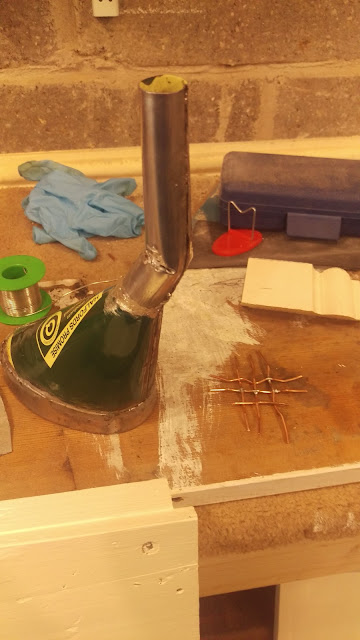You may remember me remarking on the inaccessibility of various items for maintenance, notably the oil strainer and the gearbox top bolt.
Well, as if to demonstrate this needless fact to myself I decided to cover myself in oil, last time I did the change, realising too late that the funnel I had to direct oil into the can really was too big to fit under the oil tank and no I couldn't squeeze it to fit...
So, I needed a small funnel with an offset spout. Could I find one? No. So like all good engineers I set about making one...
This is not actually a paper Shewee. Its a paper model of my funnel that I made to make sure my design would fit in that teeny tiny space under the oil tank.
Here are the tin parts. I took the paper she-wee apart again and pasted the parts onto this old oil can. Cutting around the parts with two different pairs of snips (snips are designed for cutting straight lines, or right and left hand curves, in different pairs of snips) I came up with these:
So let's stick it under the oil tank and see if it fits. Despite the narrow space around the drain plug, this will do the job. What we will need, though, is something to stop oily, slippery drain plugs disappearing down the funnel. More on that later.
This is the top of the funnel. It has a wired edge for stiffness, made by rolling the tin around a 2.5 mm copper wire, which is then wrapped around the funnel shape and joined, again using the wire and a small soldered flap
So here is the wire-edge rim and the funnel soldered together:
And here's the funnel & tube section fitted together & soldered,
As you can see this produces a funnel which doesn't align with the top of an oil can
So it needs a crank in it, like this:
And now it fits happily in the can
And it fits under the oil tank, whilst its in the can. now I can drain the oil hands-free. All I need now is something to stop the drain plug disappearing down the funnel.
And here we are, a simple mesh made from interwoven 2.5 mm copper wire:
So there we have it, an operational funnel made to fit in a couple of hours from scrap - an old oil can and a bit of 2.5 mm twin & earth, knocking about in the garage. Tools used are simple too - a 100 W soldering iron and a pair of snips.



































